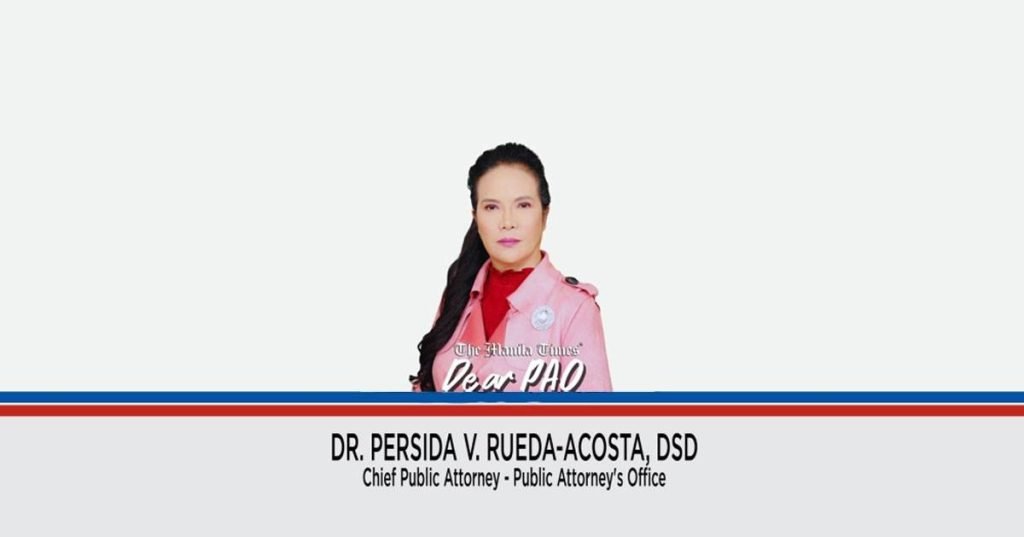
Dear PAO,
A sought advice at the Hall of Justice regarding the alleged murder of his live-in partner, B, who was killed several months ago. He was severely beaten. Sadly, there appear to be no witnesses. But A believes that the three owners of a certain store are the culprits because it was at that place where B was last seen. B’s body was also found near that store. B is short and thin compared to the three well-built bodies of the store owners. So, A claims that, in terms of strength, B had no chance to defend himself. However, the said owners denied having anything to do with B’s death and claimed that they were at home at the time of the alleged incident. A wants to pursue filing a case, but after consulting several people from the Hall of Justice, he was told that he could not pursue a case against the owners because there is no proof as to the identity of the culprit/s. Is that correct?
Jonathan
Dear Jonathan,
Murder is considered a heinous crime. No one, whatever the reason, has the lawful right to take the life of another person. Thus, anyone who is clearly and convincingly shown to have committed the crime of murder will be punished severely under our laws. Article 248 of the Revised Penal Code of the Philippines states:
“Art. 248. Murder. – Any person who, not falling within the provisions of Article 246, shall kill another shall be guilty of murder and shall be punished by reclusion temporal in its maximum period to death, if committed with any of the following attendant circumstances:
“1. With treachery, taking advantage of superior strength, with the aid of armed men, or employing means to weaken the defense or of means or persons to insure or afford impunity.
“2. In consideration of a price, reward, or promise.
“3. By means of inundation, fire, poison, explosion, shipwreck, stranding of a vessel, derailment or assault upon a street car or locomotive, fall of an airship, by means of motor vehicles, or with the use of any other means involving great waste and ruin.
“4. On occasion of any of the calamities enumerated in the preceding paragraph, or of an earthquake, eruption of a volcano, destructive cyclone, epidemic or other public calamity.
“5. With evident premeditation.
“6. With cruelty, by deliberately and inhumanly augmenting the suffering of the victim, or outraging or scoffing at his person or corpse.”
But proving who committed the crime can be extremely difficult, especially if there are no eyewitnesses. It must be emphasized that in criminal prosecutions, proof beyond a reasonable doubt is required under our laws. Further, proving that a crime has been committed is not the same as proving who committed it. There must be proof beyond reasonable doubt that a crime was committed, and independently, there must also be proof beyond reasonable doubt as to who the perpetrator of the crime is. Merely proving that a crime has been committed is worthless if it cannot be convincingly established that the accused of the crime is the one who committed it. As explained by Associate Justice Japar Dimaampao, in the case of People of the Philippines v. Jun Villegas et al. (GR 247002. April 12, 2023):
“It is ingrained in this jurisdiction that a successful prosecution of a criminal action largely depends on proof of two things: one, the identification of the author of the crime, and two, his or her actual commission of the same. An ample proof that a crime has been committed has no use if the prosecution is unable to convincingly prove the offender’s identity. The constitutional presumption of innocence that an accused enjoys is not demolished by an identification that is full of uncertainties.” (Emphasis supplied)
Accordingly, we believe that A may not successfully pursue a case for murder against the three owners of the store. Assuming that he is able to file a complaint and an Information is subsequently filed in court, it may not successfully lead to the conviction of the said owners if there is lack of evidence to prove, beyond reasonable doubt, that they are the ones who killed B, even if it can be proven that B was last seen going to the store and that he died near the said place. We have to consider that simply being the owners of the store does not equate to involvement in B’s death. There must still be concrete proof of their participation in the acts that led to the demise of B. While we empathize with A and are hopeful he finds justice for the untimely death of B, it is our duty to emphasize the necessity of presenting sufficient evidence required under our law, especially when the life and liberty of a person are at stake.
We hope that we were able to answer your queries. This advice is based solely on the facts you have narrated and our appreciation of the same. Our opinion may vary when other facts are changed or elaborated.
Editor’s note: Dear PAO is a daily column of the Public Attorney’s Office. Questions for Chief Acosta may be sent to [email protected]







